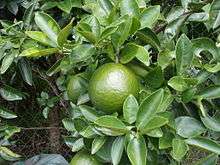Cam sành
The cam sành (Vietnamese: [kaːm ʂâjŋ̟])[1][2] or King orange (Citrus reticulata × sinensis)[1] is a citrus hybrid originating in Vietnam.
| Cam sành | |
|---|---|
 | |
| A cam sành tree | |
| Scientific classification | |
| Kingdom: | |
| (unranked): | |
| (unranked): | |
| (unranked): | |
| Order: | |
| Family: | |
| Genus: | |
| Species: | C. reticulata × sinensis |
Cam sành is Vietnamese for "terracotta orange", although the fruit is more akin to a mandarin or tangerine. The fruit may be easily recognized by its thick skin, which is typically bright green,[1] although the skin may also be partly green and partly orange, or entirely orange. Its flesh is orange, dark and sweet.[2] This is the most popular orange variety in Vietnam.
Classification
This tree is referred to as the "King Tangor" or "King Mandarin" in most horticultural literature.[3] Scion for grafting is available through the University of California Citrus Clonal Protection Program.[4] One notable difference is that in temperate climates the fruit will turn a bright orange in response to colder temperatures when the fruits ripen.[3]
It is one among many citrus fruits from the region. These include the closely related yellow cam canh and reddish to yellow cam bo ha mandarin–pomelos hybrids; the orange-colored chun or sen, yellow bak son, and pink hong orange–mandarin hybrids or "king mandarins" (C. reticulata × C. sinensis); as well as at least three non-hybridized mandarin (C. reticulata) varietals.[1] The term "king mandarin" is sometimes applied to the cam sành itself.[2]
Distribution
The tree was introduced to the United States in 1880, when the United States Minister to Japan John A. Bingham arranged for six cam sành fruits to be shipped from Saigon, Cochinchina to Dr. H. S. Magee, a nurseryman in Riverside, California. In 1882, Magee sent two seedlings and budwood to J. C. Stovin in Winter Park, Florida.[5][6]
In Vietnam, the tree is cultivated in the Mỏ Cày District, Bến Tre Province,[1] as well as the northern mountainous areas.[1][2] It has also been grown in the Bố Hạ region of Yên Thế (Yên District) of Bắc Giang Province,[2] but had been eradicated due to the citrus greening disease. Nowadays, cam sành is planted widely in northeastern Vietnam (particularly Hà Giang, Tuyên Quang, and Yên Bái), as well as in several provinces of the Mekong Delta in the south, including Vĩnh Long, Cần Thơ, and Tiền Giang.
Cultivation
It prefers alluvial soil, and a cool, moist climate, but is widely adaptable,[2] and does well at comparatively high altitudes.[1][2] Yield is high, with an average fruit weight of 150–250 g.[2]
References
- "Fruits of Vietnam".
- "Công nghệ tuyển chọn và nhân giống cây có múi sạch bệnh". Archived from the original on 2010-11-21. Retrieved 2007-10-19.
- Riverside, University Of California. "King tangor Citrus nobilis Lour". Citrus Variety Collection. UCR. Retrieved 29 May 2012.
- UCR, Riverside. "Citrus Clonal Program Info Site". Retrieved 29 May 2012.
- "Mandarin Orange".
- "Horticultural Varieties of Citrus". Archived from the original on 2008-03-08. Retrieved 2007-10-19.